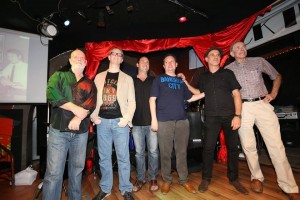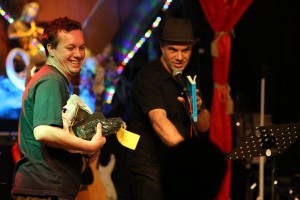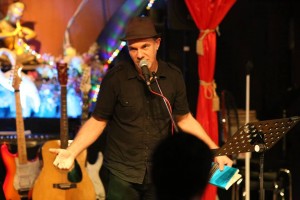Bangkok based writer James Newman organized the third Bangkok Night of Noir at CheckInn99, a club cum bar on Sukhumvit Road, last month.
The venue, once the haunt of the likes of Bob Hope and David Bowie (probably not on the same nights) was packed with as many punters as local ex-pat writers and aspirants and the authors’ readings, mercifully short and succinct in each case, were received enthusiastically.
This year, pulp author and publisher James Newman created a mixed line-up of poets, painters and writers including Jame DiBiasio from Hong Kong, old Asia hand Dean Barrett, the poet John Gartland, Newman’s partner at Spanking Pulp Press John Daysh from New Zealand, Kevin Wood, Harlan Wolff, the painter Chris Coles who exhibited many of his brilliantly garish impressions of Bangkok’s nightlife. and myself. A photographic slideshow of Bangkok’s neon zones by Stickman ran on various screens for parts of the evening and was harsh and gratuitous enough to out-gross any of the fiction being read, and that, I suppose is saying something on a night of Noir.
Prior to his attendance, Jame DiBiasio, author of Asian based thriller Gaijin Cowgirl, published by Crime Wave Press, wrote a rather dry blog post on his site Asiahacks . Jame flew in from Hong Kong for the event. We last met at the Irrawaddy Literary Festival in Mandalay last year and it was great to reconnect with one of my writers face to face again.
In any case, James Newman introduced the artists and read a sickeningly beautiful short story he had written a decade or so earlier. Bangkok fiction Night of Noir gets no financial or sponsorship support at all. It’s a truly independent event and ever so slightly underground, despite its impressive list of part attendees – including Christopher G Moore, John Burdett and Carla Black.
Jame DiBiasio read from Gaijin Cowgirl and followed up on the event with a second blog post at Asiahacks entitled Il n’y a pas Charlie Hebdo ici. in which he raises interesting points on the culture and politics of crime writing in Southeast Asia.
Says DiBiasio, “The biggest barrier to putting Asian Noir on the global map, however, is the fact that we, generically speaking, are not free to use fiction to discuss the true nature of power in this region.
This was the third time James invited me to the Bangkok Fiction Night of Noir and I hugely enjoy participating as a crime fiction publisher as well as an author not least because the events serve as a barometer reading of the relative health of Bangkok’s crime fiction literary scene, which is tiny and diffuse.
I read a chapter from my first novel The Devil’s Road to Kathmandu. The scene takes place in a decadent night club in pre-revolutionary Iran. As I was reading just a few days after the Charlie Hebdo killings, I wanted to read something relating to the mood of the day, the Zeitgeist. A chapter on Iranian nightlife – suffused with booze, sex and drugs and a certain foggy magic – seemed the most appropriate text I could think of. In the cavernous, semi-lit, nostalgic neon night and beer infused ambiance of the Checkinn 99, my opening words, ‘Sallam Malaikum’ seemed to resonate with the same magic. At least to me.
Hope James Newman will continue with another event next year.
Just for a laugh, here’s the Bangkok Post review of The Devil’s Road to Kathmandu, penned by possibly legendary journalist Bernhard Trink from 2006.
Global trekking across Asia is becoming increasingly difficult. War, terrorism, ever tighter Immigration rules are blocking the traditional land routes. And travel by plane doesn’t qualify as backpacking. Authors of wayfaring novels must set them years ago to make them plausible.
Which is what British freelance journalist Tom Vater does in his first book of fiction The Devil’s Road to Kathmandu. In fact he sets the story in two different years, 1976 and 2000, alternating between them. The years are safe, the first prior to the overthrow of the Shah in Iran, the second prior to the US invasion of Afghanistan. They, along with Pakistan and Nepal are the key countries in the plot.
The author makes a serious effort to capture the mindset of the backpacker. The characters are always stoned, hump like minks, seek to connect with the vital force of the universe. If there’s a way to make money without working for it, even when dangerous, they go for it.
In 1976, Dan, Tim and Fred pool their savings and buy a second-hand Bedford bus and head for the East. What they have in common is the determination to reach the Khyber Pass, buy drugs and re-sell them at a substantial profit. Experiences along the way are detailed. At one point they pick up Thierry, the Frenchman dealing himself in.
There are girls, of course, every bit as horny. Making the strongest impressions are Lida and Madi, Armenian sisters, entertainers, Siamese twins. Immigration officers are invariably corrupt, demanding bakshish to stamp their passports.
The deal almost proves fatal to no fault of their own. The Pathans involved are having a blood feud, shots are exchanged and some passengers die. Though they get the money, it’s safer to deposit it in a Kathmandu bank than to attempt to bring it home with them. Thierry decides to stay in Asia, marrying Madi after a Stateside operation separates the twins. Fred disappears.
A quarter-century later Fred, presumed dead, e-mails his partners to come back, in order to withdraw the deposit together. Dan brings his son, Robbie. Alas the money has already been taken by a man called Marlowe and Fred is ensconced in the highest temple in the Himalayas. He never sent the e-mails, but Thierry did using his name.
The Devil’s Road to Kathmandu is a better backpacker’s book than Alex Garland’s The Beach.
Khao San Road’s habitues will go for it.
The book is out as ebook and print with Crime Wave Press. A Spanish language edition is out with EditorialXplora.





